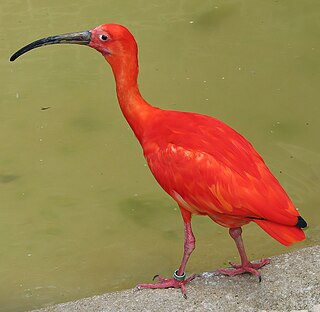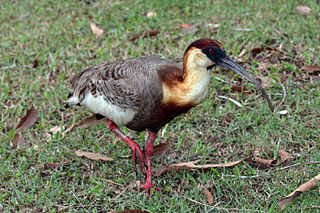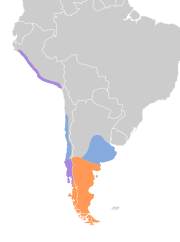
Spoonbills are a genus, Platalea, of large, long-legged wading birds. The spoonbills have a global distribution, being found on every continent except Antarctica. The genus name Platalea derives from Ancient Greek and means "broad", referring to the distinctive shape of the bill. Six species are recognised, which although usually placed in a single genus have sometimes been split into three genera.

The family Threskiornithidae includes 36 species of large wading birds. The family has been traditionally classified into two subfamilies, the ibises and the spoonbills; however recent genetic studies have cast doubt on this arrangement, and have found the spoonbills to be nested within the Old World ibises, and the New World ibises as an early offshoot.

The magpie-robins or shamas are medium-sized insectivorous birds in the genus Copsychus. They were formerly in the thrush family Turdidae, but are now treated as part of the Old World flycatcher family Muscicapidae. They are garden- and forest-dwelling species found in Africa and Asia.

The double-spurred spurfowl is a gamebird in the pheasant family Phasianidae of the order Galliformes, gallinaceous birds. Like most spurfowls, it is restricted to Africa. It is a resident breeder in tropical west Africa, but there is a small and declining isolated population in Morocco.

The red-necked spurfowl or red-necked francolin, is a gamebird in the pheasant family Phasianidae that is a resident species in southern Africa.

The small bird genus Geronticus belongs to the ibis subfamily Threskiornithinae. Its name is derived from the Greek gérontos in reference to the bald head of these dark-plumaged birds; in English, they are called bald ibises.

The green ibis, also known as the Cayenne ibis, is a wading bird in the ibis family Threskiornithidae. It is the only member of the genus Mesembrinibis.

The southern bald ibis is a large bird found in open grassland or semi-desert in the mountains of southern Africa. Taxonomically, it is most closely related to its counterpart in the northern regions of Africa, the waldrapp. As a species, it has a very restricted homerange, limited to the southern tips of South Africa in highland and mountainous regions.

The buff-necked ibis, also known as the white-throated ibis, is a fairly large ibis found widely in open habitats of eastern and northern South America. It formerly included the similar black-faced ibis as a subspecies, but that species is almost entirely restricted to colder parts of South America, has a buff lower chest, and lacks the contrasting large white wing-patches.

The red-billed spurfowl, also known as the red-billed francolin, is a species of bird in the family Phasianidae. It is found in Southern Africa, including Angola, Botswana, Namibia, South Africa, Zambia, and Zimbabwe.

The Ahanta francolin or Ahanta spurfowl is a species of bird in the pheasant family, Phasianidae. It is native to western Africa, where it occurs in Benin, Ivory Coast, Gambia, Ghana, Guinea, Guinea-Bissau, Liberia, Mali, Nigeria, Senegal, Sierra Leone, and Togo.

The chestnut-naped spurfowl is a species of bird in the pheasant family Phasianidae. At 33–37 cm (13–15 in) in length and weighing 550–1,200 g (19–42 oz), it is a large species of spurfowl. It is found in Ethiopia and Somaliland. The population is believed to be stable but according to the International Union for Conservation of Nature (IUCN) there is insufficient data to make an estimate of the population.

Erckel's spurfowl, also known as Erckel's francolin, is a species of game bird in the family Phasianidae.

The grey-striped spurfowl is a species of bird in the family Phasianidae. It is found only in Angola.

Jackson's spurfowl or Jackson's francolin is a species of bird in the family Phasianidae. It is found in Kenya and Uganda. Its preferred habitats include mountainous forests and stands of bamboo.

Hydropsalis is a genus of nightjars in the family Caprimulgidae. The species are widely distributed across the tropical and subtropical regions of the New World.

The large-billed tern is a species of tern in the family Laridae. It is placed the monotypic genus Phaetusa. It is found in most of South America. It has occurred as a vagrant in Aruba, Bermuda, Cuba, Panama and the United States. Its natural habitats are rivers and freshwater lakes.

The black-faced ibis is a species of bird in the family Threskiornithidae. It is found in grassland and fields in southern and western South America. It has been included as a subspecies of the similar buff-necked ibis, but today all major authorities accept the split. The black-faced ibis also includes the Andean ibis as a subspecies. Some taxonomic authorities still do so.

Tanygnathus is a genus of parrots in the Psittaculini tribe, of the superfamily of Psittacoidea.

The Andean ibis is a species of bird in the family Threskiornithidae. It is found in grassland and fields in western South America. This species was considered a subspecies of the black-faced ibis, and some taxonomic authorities still consider it so.





























